HI6006 - Strategic Tools: PESTEL, Porter's Five Forces & RBV Model
VerifiedAdded on 2023/06/13
|8
|1688
|242
Essay
AI Summary
This essay provides an overview of strategic management tools and their application in business processes. It focuses on three key tools: PESTEL analysis, Porter's Five Forces, and the Resource-Based View (RBV) model. The PESTEL analysis examines macro-environmental factors (Political, Economic, Social, Technological, Environmental, and Legal) affecting an organization. Porter's Five Forces assesses industry attractiveness by analyzing the threat of substitutes, the threat of new entrants, the bargaining power of buyers and suppliers, and industry rivalry. The Resource-Based View model emphasizes leveraging tangible and intangible resources to gain a competitive advantage, highlighting the importance of resource heterogeneity, immobility, and the VRIO framework (Value, Rarity, Imitability, Organization). The essay concludes that these strategic tools are essential for informed decision-making and achieving organizational success.
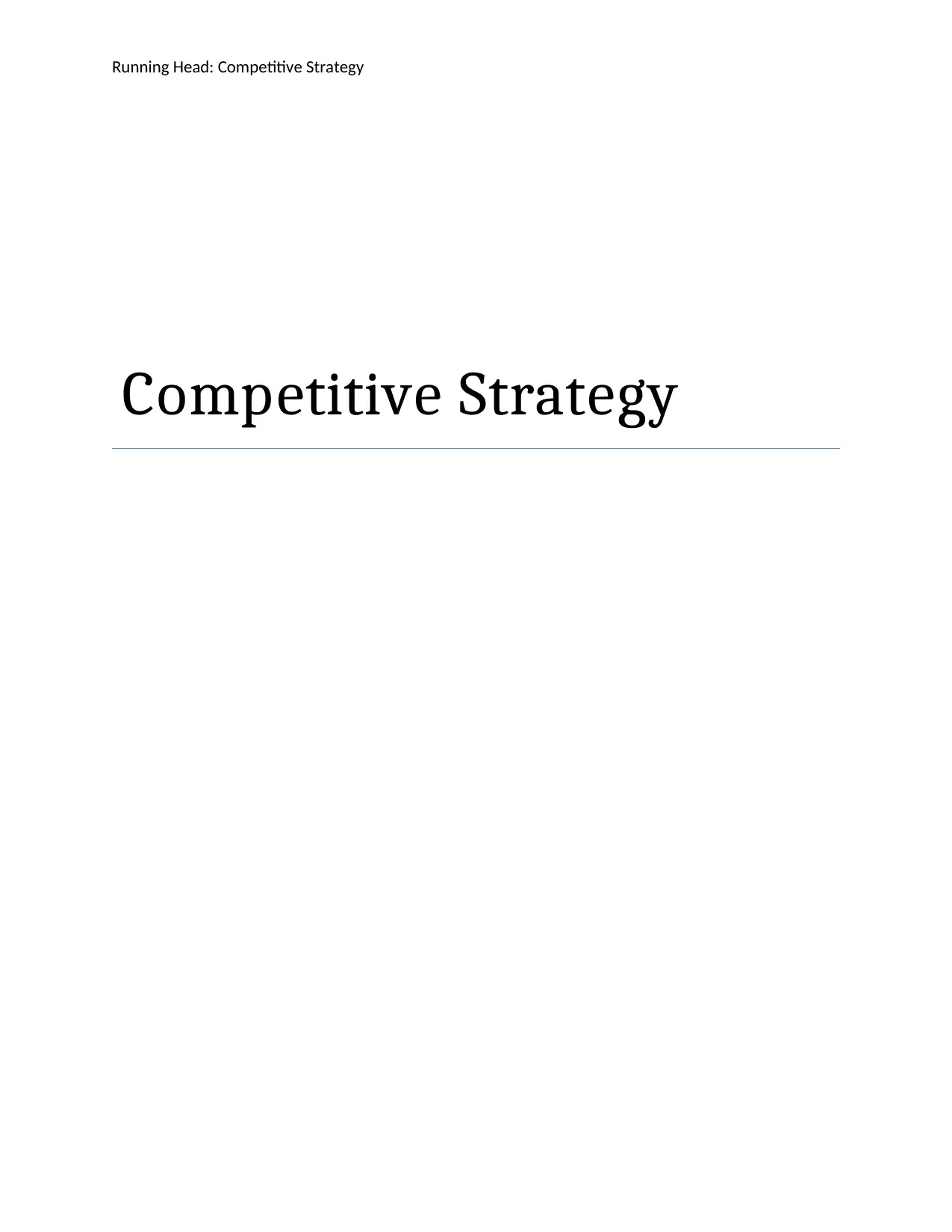
Running Head: Competitive Strategy
Competitive Strategy
Competitive Strategy
Paraphrase This Document
Need a fresh take? Get an instant paraphrase of this document with our AI Paraphraser
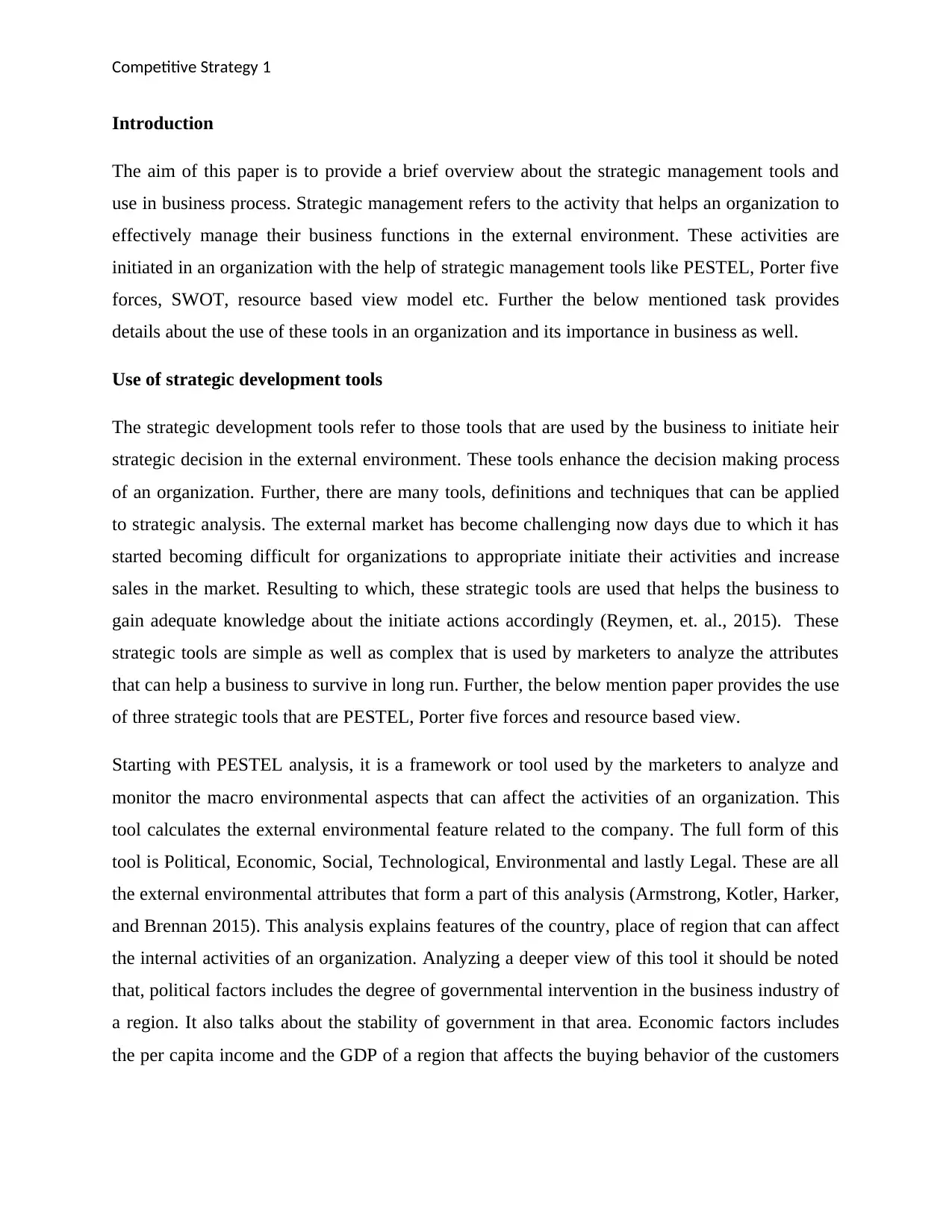
Competitive Strategy 1
Introduction
The aim of this paper is to provide a brief overview about the strategic management tools and
use in business process. Strategic management refers to the activity that helps an organization to
effectively manage their business functions in the external environment. These activities are
initiated in an organization with the help of strategic management tools like PESTEL, Porter five
forces, SWOT, resource based view model etc. Further the below mentioned task provides
details about the use of these tools in an organization and its importance in business as well.
Use of strategic development tools
The strategic development tools refer to those tools that are used by the business to initiate heir
strategic decision in the external environment. These tools enhance the decision making process
of an organization. Further, there are many tools, definitions and techniques that can be applied
to strategic analysis. The external market has become challenging now days due to which it has
started becoming difficult for organizations to appropriate initiate their activities and increase
sales in the market. Resulting to which, these strategic tools are used that helps the business to
gain adequate knowledge about the initiate actions accordingly (Reymen, et. al., 2015). These
strategic tools are simple as well as complex that is used by marketers to analyze the attributes
that can help a business to survive in long run. Further, the below mention paper provides the use
of three strategic tools that are PESTEL, Porter five forces and resource based view.
Starting with PESTEL analysis, it is a framework or tool used by the marketers to analyze and
monitor the macro environmental aspects that can affect the activities of an organization. This
tool calculates the external environmental feature related to the company. The full form of this
tool is Political, Economic, Social, Technological, Environmental and lastly Legal. These are all
the external environmental attributes that form a part of this analysis (Armstrong, Kotler, Harker,
and Brennan 2015). This analysis explains features of the country, place of region that can affect
the internal activities of an organization. Analyzing a deeper view of this tool it should be noted
that, political factors includes the degree of governmental intervention in the business industry of
a region. It also talks about the stability of government in that area. Economic factors includes
the per capita income and the GDP of a region that affects the buying behavior of the customers
Introduction
The aim of this paper is to provide a brief overview about the strategic management tools and
use in business process. Strategic management refers to the activity that helps an organization to
effectively manage their business functions in the external environment. These activities are
initiated in an organization with the help of strategic management tools like PESTEL, Porter five
forces, SWOT, resource based view model etc. Further the below mentioned task provides
details about the use of these tools in an organization and its importance in business as well.
Use of strategic development tools
The strategic development tools refer to those tools that are used by the business to initiate heir
strategic decision in the external environment. These tools enhance the decision making process
of an organization. Further, there are many tools, definitions and techniques that can be applied
to strategic analysis. The external market has become challenging now days due to which it has
started becoming difficult for organizations to appropriate initiate their activities and increase
sales in the market. Resulting to which, these strategic tools are used that helps the business to
gain adequate knowledge about the initiate actions accordingly (Reymen, et. al., 2015). These
strategic tools are simple as well as complex that is used by marketers to analyze the attributes
that can help a business to survive in long run. Further, the below mention paper provides the use
of three strategic tools that are PESTEL, Porter five forces and resource based view.
Starting with PESTEL analysis, it is a framework or tool used by the marketers to analyze and
monitor the macro environmental aspects that can affect the activities of an organization. This
tool calculates the external environmental feature related to the company. The full form of this
tool is Political, Economic, Social, Technological, Environmental and lastly Legal. These are all
the external environmental attributes that form a part of this analysis (Armstrong, Kotler, Harker,
and Brennan 2015). This analysis explains features of the country, place of region that can affect
the internal activities of an organization. Analyzing a deeper view of this tool it should be noted
that, political factors includes the degree of governmental intervention in the business industry of
a region. It also talks about the stability of government in that area. Economic factors includes
the per capita income and the GDP of a region that affects the buying behavior of the customers
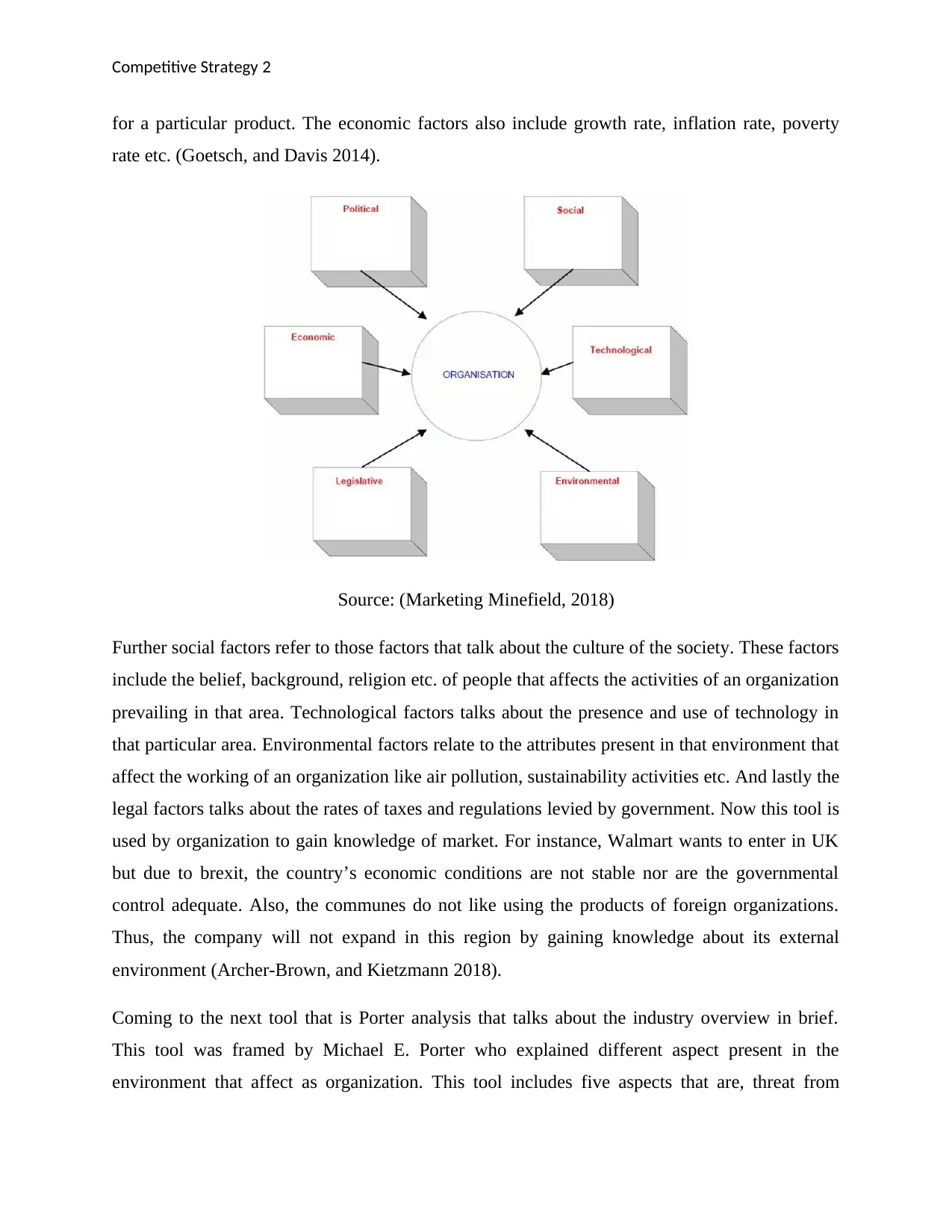
Competitive Strategy 2
for a particular product. The economic factors also include growth rate, inflation rate, poverty
rate etc. (Goetsch, and Davis 2014).
Source: (Marketing Minefield, 2018)
Further social factors refer to those factors that talk about the culture of the society. These factors
include the belief, background, religion etc. of people that affects the activities of an organization
prevailing in that area. Technological factors talks about the presence and use of technology in
that particular area. Environmental factors relate to the attributes present in that environment that
affect the working of an organization like air pollution, sustainability activities etc. And lastly the
legal factors talks about the rates of taxes and regulations levied by government. Now this tool is
used by organization to gain knowledge of market. For instance, Walmart wants to enter in UK
but due to brexit, the country’s economic conditions are not stable nor are the governmental
control adequate. Also, the communes do not like using the products of foreign organizations.
Thus, the company will not expand in this region by gaining knowledge about its external
environment (Archer-Brown, and Kietzmann 2018).
Coming to the next tool that is Porter analysis that talks about the industry overview in brief.
This tool was framed by Michael E. Porter who explained different aspect present in the
environment that affect as organization. This tool includes five aspects that are, threat from
for a particular product. The economic factors also include growth rate, inflation rate, poverty
rate etc. (Goetsch, and Davis 2014).
Source: (Marketing Minefield, 2018)
Further social factors refer to those factors that talk about the culture of the society. These factors
include the belief, background, religion etc. of people that affects the activities of an organization
prevailing in that area. Technological factors talks about the presence and use of technology in
that particular area. Environmental factors relate to the attributes present in that environment that
affect the working of an organization like air pollution, sustainability activities etc. And lastly the
legal factors talks about the rates of taxes and regulations levied by government. Now this tool is
used by organization to gain knowledge of market. For instance, Walmart wants to enter in UK
but due to brexit, the country’s economic conditions are not stable nor are the governmental
control adequate. Also, the communes do not like using the products of foreign organizations.
Thus, the company will not expand in this region by gaining knowledge about its external
environment (Archer-Brown, and Kietzmann 2018).
Coming to the next tool that is Porter analysis that talks about the industry overview in brief.
This tool was framed by Michael E. Porter who explained different aspect present in the
environment that affect as organization. This tool includes five aspects that are, threat from
⊘ This is a preview!⊘
Do you want full access?
Subscribe today to unlock all pages.

Trusted by 1+ million students worldwide
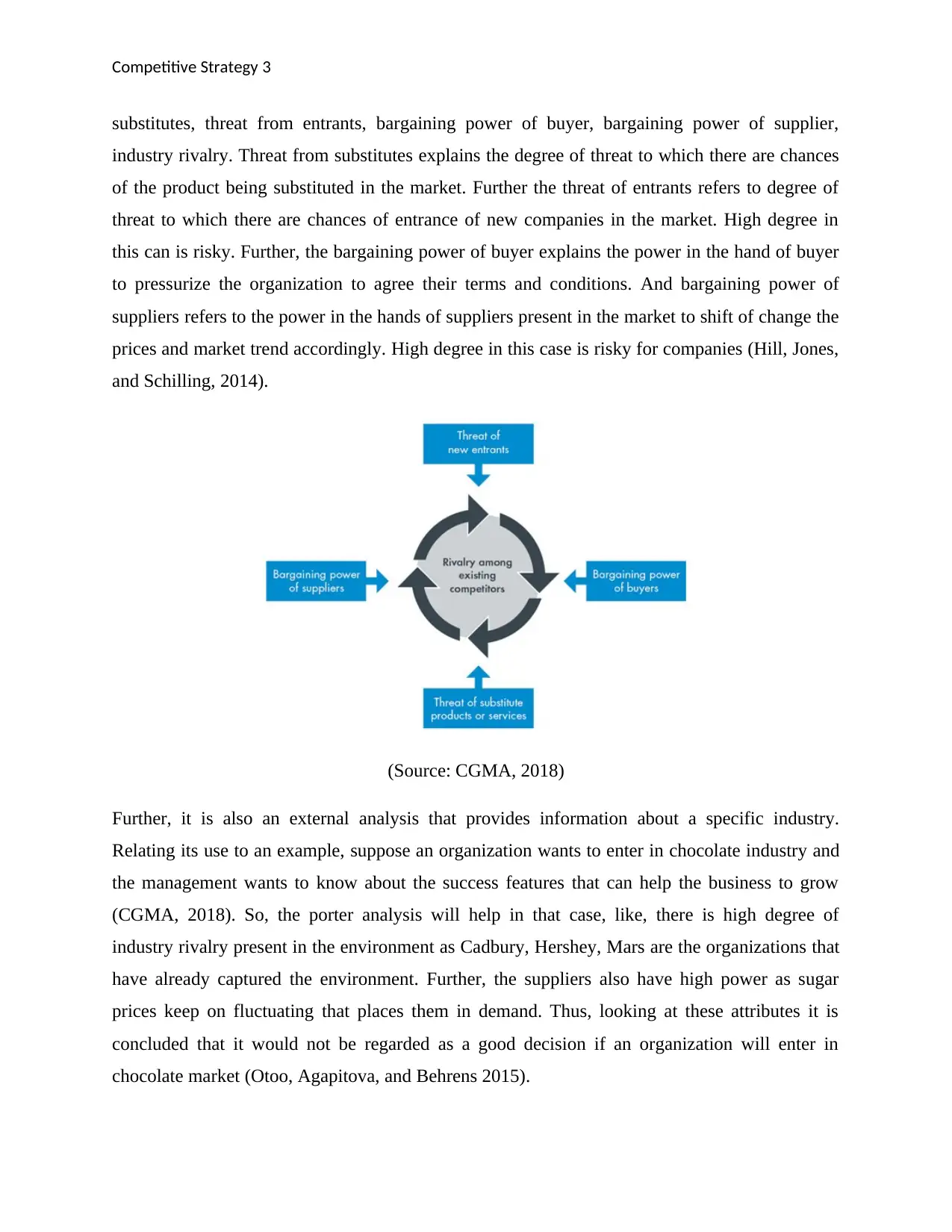
Competitive Strategy 3
substitutes, threat from entrants, bargaining power of buyer, bargaining power of supplier,
industry rivalry. Threat from substitutes explains the degree of threat to which there are chances
of the product being substituted in the market. Further the threat of entrants refers to degree of
threat to which there are chances of entrance of new companies in the market. High degree in
this can is risky. Further, the bargaining power of buyer explains the power in the hand of buyer
to pressurize the organization to agree their terms and conditions. And bargaining power of
suppliers refers to the power in the hands of suppliers present in the market to shift of change the
prices and market trend accordingly. High degree in this case is risky for companies (Hill, Jones,
and Schilling, 2014).
(Source: CGMA, 2018)
Further, it is also an external analysis that provides information about a specific industry.
Relating its use to an example, suppose an organization wants to enter in chocolate industry and
the management wants to know about the success features that can help the business to grow
(CGMA, 2018). So, the porter analysis will help in that case, like, there is high degree of
industry rivalry present in the environment as Cadbury, Hershey, Mars are the organizations that
have already captured the environment. Further, the suppliers also have high power as sugar
prices keep on fluctuating that places them in demand. Thus, looking at these attributes it is
concluded that it would not be regarded as a good decision if an organization will enter in
chocolate market (Otoo, Agapitova, and Behrens 2015).
substitutes, threat from entrants, bargaining power of buyer, bargaining power of supplier,
industry rivalry. Threat from substitutes explains the degree of threat to which there are chances
of the product being substituted in the market. Further the threat of entrants refers to degree of
threat to which there are chances of entrance of new companies in the market. High degree in
this can is risky. Further, the bargaining power of buyer explains the power in the hand of buyer
to pressurize the organization to agree their terms and conditions. And bargaining power of
suppliers refers to the power in the hands of suppliers present in the market to shift of change the
prices and market trend accordingly. High degree in this case is risky for companies (Hill, Jones,
and Schilling, 2014).
(Source: CGMA, 2018)
Further, it is also an external analysis that provides information about a specific industry.
Relating its use to an example, suppose an organization wants to enter in chocolate industry and
the management wants to know about the success features that can help the business to grow
(CGMA, 2018). So, the porter analysis will help in that case, like, there is high degree of
industry rivalry present in the environment as Cadbury, Hershey, Mars are the organizations that
have already captured the environment. Further, the suppliers also have high power as sugar
prices keep on fluctuating that places them in demand. Thus, looking at these attributes it is
concluded that it would not be regarded as a good decision if an organization will enter in
chocolate market (Otoo, Agapitova, and Behrens 2015).
Paraphrase This Document
Need a fresh take? Get an instant paraphrase of this document with our AI Paraphraser
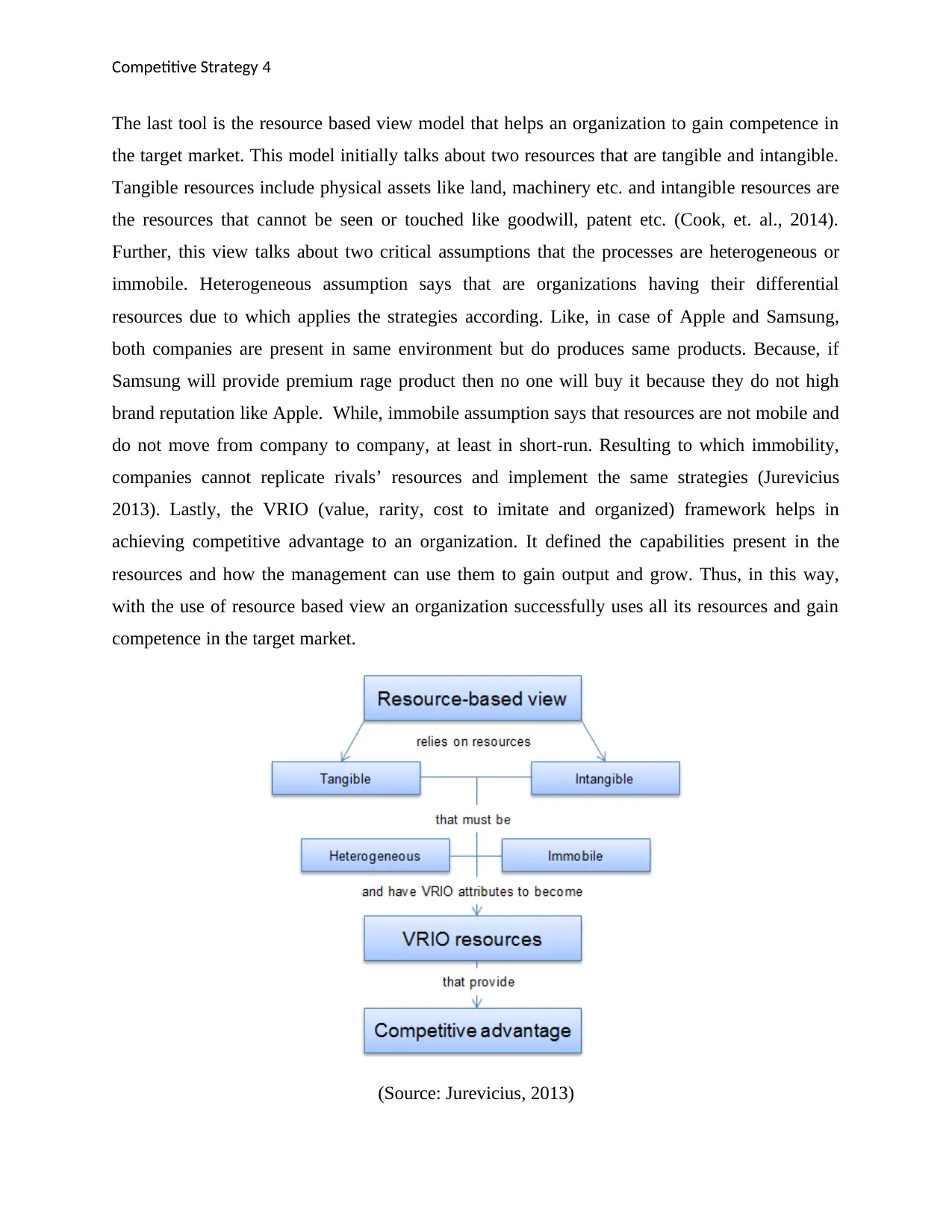
Competitive Strategy 4
The last tool is the resource based view model that helps an organization to gain competence in
the target market. This model initially talks about two resources that are tangible and intangible.
Tangible resources include physical assets like land, machinery etc. and intangible resources are
the resources that cannot be seen or touched like goodwill, patent etc. (Cook, et. al., 2014).
Further, this view talks about two critical assumptions that the processes are heterogeneous or
immobile. Heterogeneous assumption says that are organizations having their differential
resources due to which applies the strategies according. Like, in case of Apple and Samsung,
both companies are present in same environment but do produces same products. Because, if
Samsung will provide premium rage product then no one will buy it because they do not high
brand reputation like Apple. While, immobile assumption says that resources are not mobile and
do not move from company to company, at least in short-run. Resulting to which immobility,
companies cannot replicate rivals’ resources and implement the same strategies (Jurevicius
2013). Lastly, the VRIO (value, rarity, cost to imitate and organized) framework helps in
achieving competitive advantage to an organization. It defined the capabilities present in the
resources and how the management can use them to gain output and grow. Thus, in this way,
with the use of resource based view an organization successfully uses all its resources and gain
competence in the target market.
(Source: Jurevicius, 2013)
The last tool is the resource based view model that helps an organization to gain competence in
the target market. This model initially talks about two resources that are tangible and intangible.
Tangible resources include physical assets like land, machinery etc. and intangible resources are
the resources that cannot be seen or touched like goodwill, patent etc. (Cook, et. al., 2014).
Further, this view talks about two critical assumptions that the processes are heterogeneous or
immobile. Heterogeneous assumption says that are organizations having their differential
resources due to which applies the strategies according. Like, in case of Apple and Samsung,
both companies are present in same environment but do produces same products. Because, if
Samsung will provide premium rage product then no one will buy it because they do not high
brand reputation like Apple. While, immobile assumption says that resources are not mobile and
do not move from company to company, at least in short-run. Resulting to which immobility,
companies cannot replicate rivals’ resources and implement the same strategies (Jurevicius
2013). Lastly, the VRIO (value, rarity, cost to imitate and organized) framework helps in
achieving competitive advantage to an organization. It defined the capabilities present in the
resources and how the management can use them to gain output and grow. Thus, in this way,
with the use of resource based view an organization successfully uses all its resources and gain
competence in the target market.
(Source: Jurevicius, 2013)
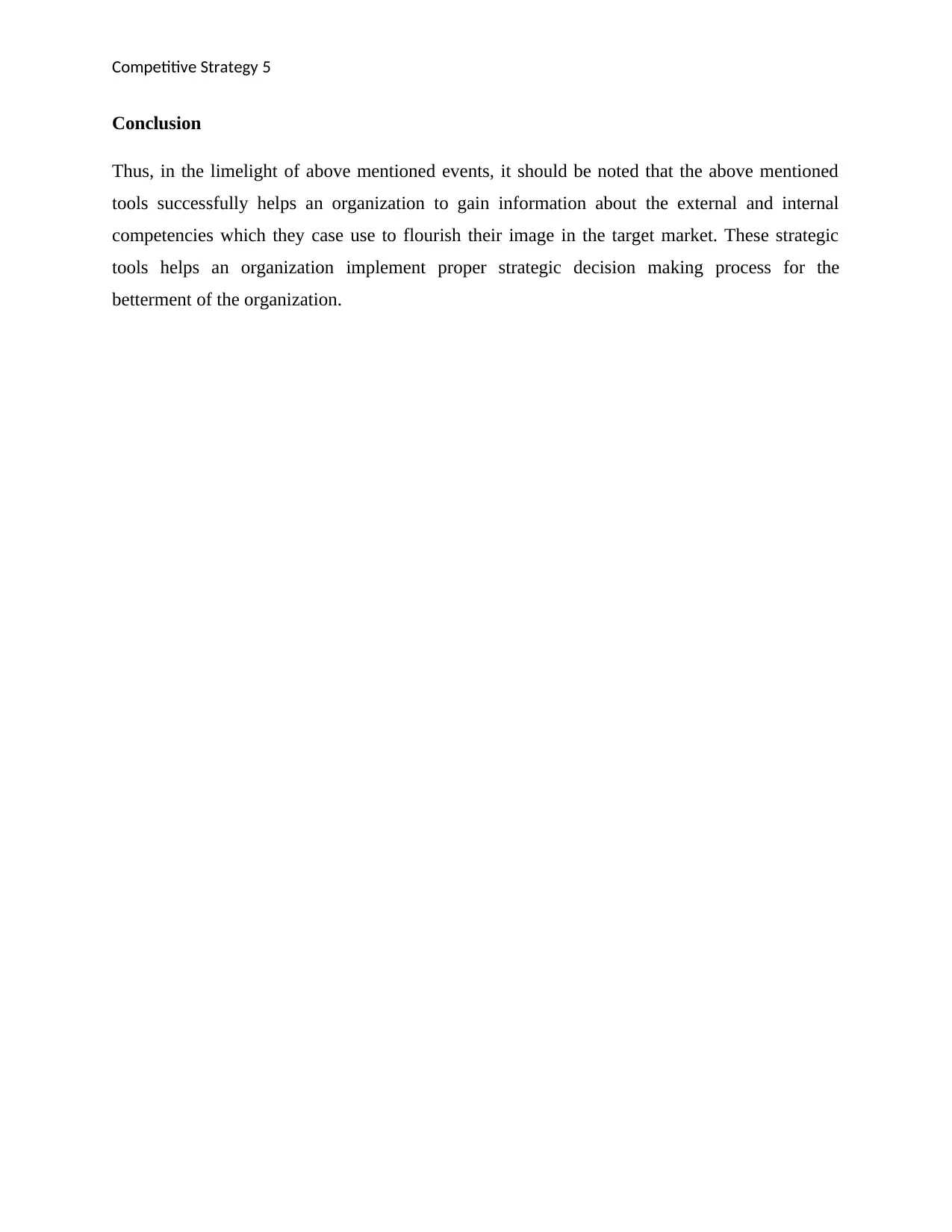
Competitive Strategy 5
Conclusion
Thus, in the limelight of above mentioned events, it should be noted that the above mentioned
tools successfully helps an organization to gain information about the external and internal
competencies which they case use to flourish their image in the target market. These strategic
tools helps an organization implement proper strategic decision making process for the
betterment of the organization.
Conclusion
Thus, in the limelight of above mentioned events, it should be noted that the above mentioned
tools successfully helps an organization to gain information about the external and internal
competencies which they case use to flourish their image in the target market. These strategic
tools helps an organization implement proper strategic decision making process for the
betterment of the organization.
⊘ This is a preview!⊘
Do you want full access?
Subscribe today to unlock all pages.

Trusted by 1+ million students worldwide
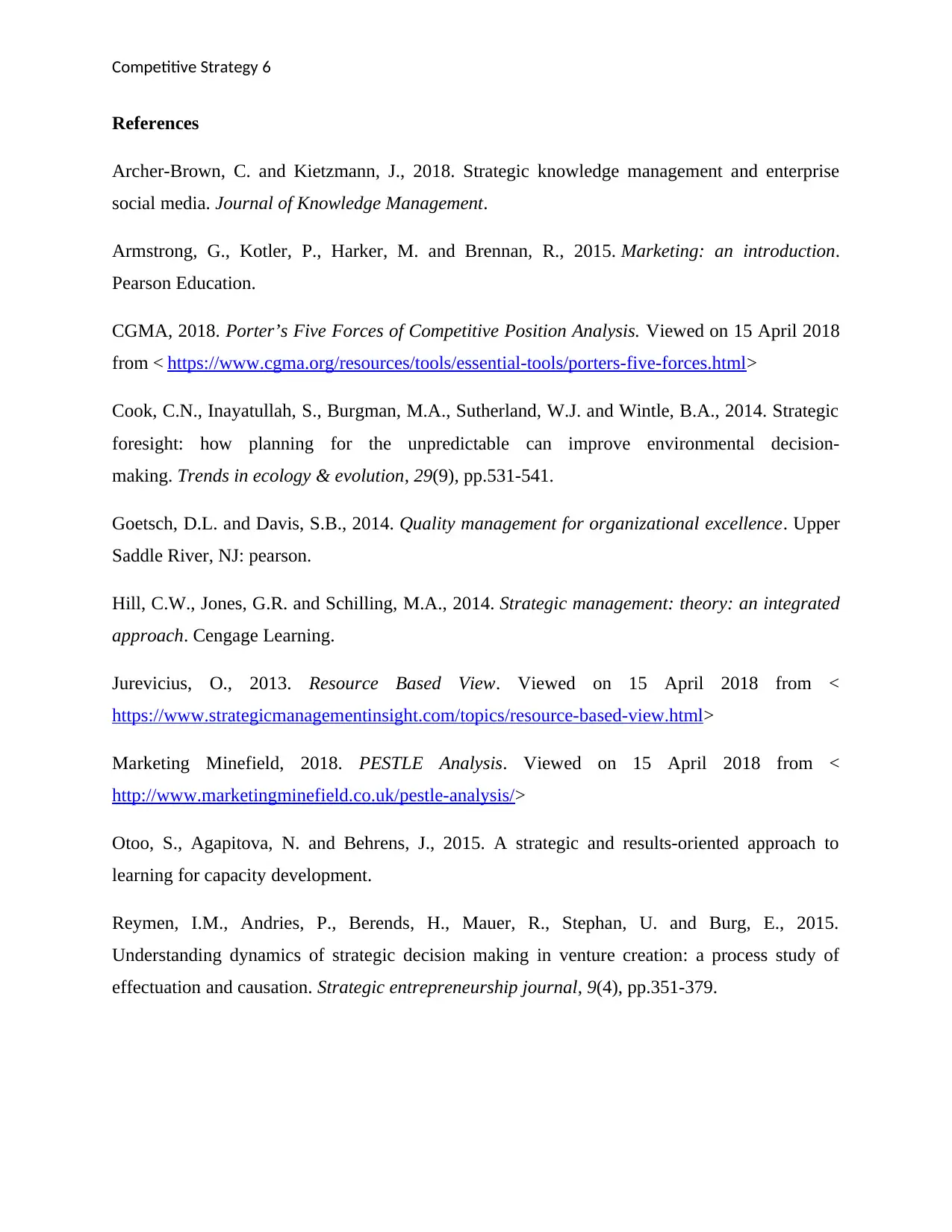
Competitive Strategy 6
References
Archer-Brown, C. and Kietzmann, J., 2018. Strategic knowledge management and enterprise
social media. Journal of Knowledge Management.
Armstrong, G., Kotler, P., Harker, M. and Brennan, R., 2015. Marketing: an introduction.
Pearson Education.
CGMA, 2018. Porter’s Five Forces of Competitive Position Analysis. Viewed on 15 April 2018
from < https://www.cgma.org/resources/tools/essential-tools/porters-five-forces.html>
Cook, C.N., Inayatullah, S., Burgman, M.A., Sutherland, W.J. and Wintle, B.A., 2014. Strategic
foresight: how planning for the unpredictable can improve environmental decision-
making. Trends in ecology & evolution, 29(9), pp.531-541.
Goetsch, D.L. and Davis, S.B., 2014. Quality management for organizational excellence. Upper
Saddle River, NJ: pearson.
Hill, C.W., Jones, G.R. and Schilling, M.A., 2014. Strategic management: theory: an integrated
approach. Cengage Learning.
Jurevicius, O., 2013. Resource Based View. Viewed on 15 April 2018 from <
https://www.strategicmanagementinsight.com/topics/resource-based-view.html>
Marketing Minefield, 2018. PESTLE Analysis. Viewed on 15 April 2018 from <
http://www.marketingminefield.co.uk/pestle-analysis/>
Otoo, S., Agapitova, N. and Behrens, J., 2015. A strategic and results-oriented approach to
learning for capacity development.
Reymen, I.M., Andries, P., Berends, H., Mauer, R., Stephan, U. and Burg, E., 2015.
Understanding dynamics of strategic decision making in venture creation: a process study of
effectuation and causation. Strategic entrepreneurship journal, 9(4), pp.351-379.
References
Archer-Brown, C. and Kietzmann, J., 2018. Strategic knowledge management and enterprise
social media. Journal of Knowledge Management.
Armstrong, G., Kotler, P., Harker, M. and Brennan, R., 2015. Marketing: an introduction.
Pearson Education.
CGMA, 2018. Porter’s Five Forces of Competitive Position Analysis. Viewed on 15 April 2018
from < https://www.cgma.org/resources/tools/essential-tools/porters-five-forces.html>
Cook, C.N., Inayatullah, S., Burgman, M.A., Sutherland, W.J. and Wintle, B.A., 2014. Strategic
foresight: how planning for the unpredictable can improve environmental decision-
making. Trends in ecology & evolution, 29(9), pp.531-541.
Goetsch, D.L. and Davis, S.B., 2014. Quality management for organizational excellence. Upper
Saddle River, NJ: pearson.
Hill, C.W., Jones, G.R. and Schilling, M.A., 2014. Strategic management: theory: an integrated
approach. Cengage Learning.
Jurevicius, O., 2013. Resource Based View. Viewed on 15 April 2018 from <
https://www.strategicmanagementinsight.com/topics/resource-based-view.html>
Marketing Minefield, 2018. PESTLE Analysis. Viewed on 15 April 2018 from <
http://www.marketingminefield.co.uk/pestle-analysis/>
Otoo, S., Agapitova, N. and Behrens, J., 2015. A strategic and results-oriented approach to
learning for capacity development.
Reymen, I.M., Andries, P., Berends, H., Mauer, R., Stephan, U. and Burg, E., 2015.
Understanding dynamics of strategic decision making in venture creation: a process study of
effectuation and causation. Strategic entrepreneurship journal, 9(4), pp.351-379.
Paraphrase This Document
Need a fresh take? Get an instant paraphrase of this document with our AI Paraphraser
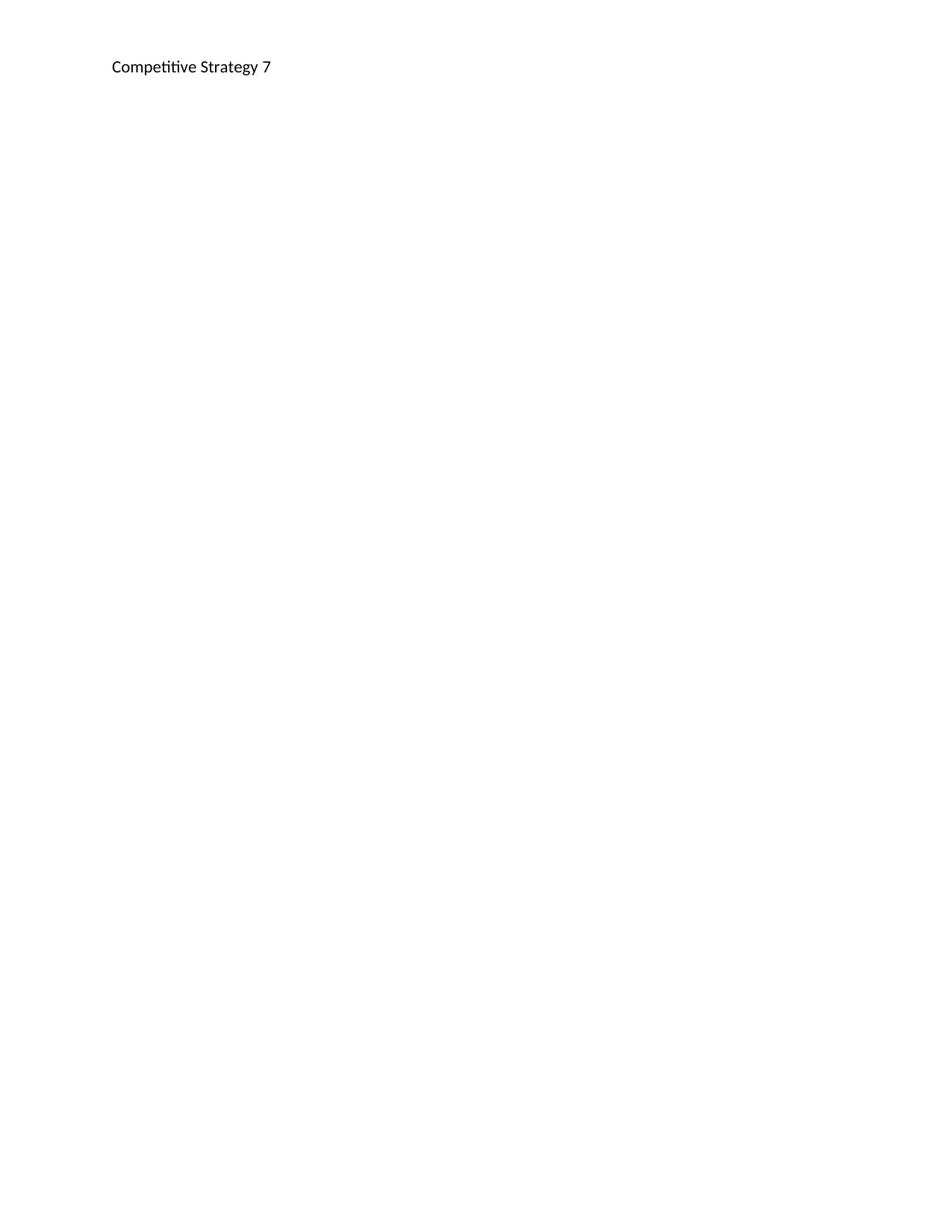
Competitive Strategy 7
1 out of 8
Related Documents
Your All-in-One AI-Powered Toolkit for Academic Success.
+13062052269
info@desklib.com
Available 24*7 on WhatsApp / Email
![[object Object]](/_next/static/media/star-bottom.7253800d.svg)
Unlock your academic potential
Copyright © 2020–2025 A2Z Services. All Rights Reserved. Developed and managed by ZUCOL.


